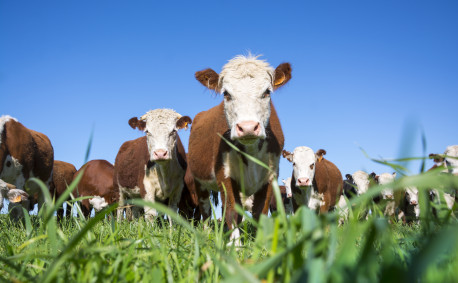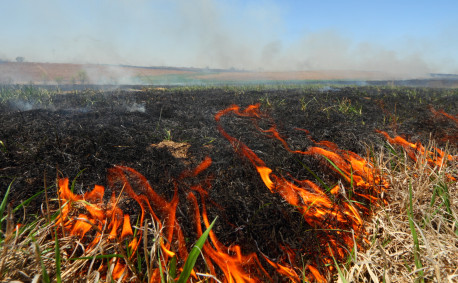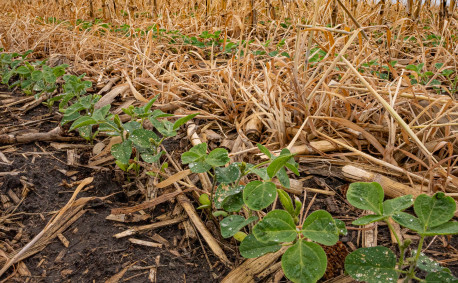5 Ways Farmers Help the Environment
Environmental sustainability has been in the spotlight recently — for good reason! Protecting our natural resources is a global priority. Sustainability has been a main concern in agriculture for generations and it shows.
Agriculture contributes less than 10% of greenhouse gas emissions in the U.S. That’s less than half of other sectors like transportation (28%), electricity (25%) and industry (23%), according to the EPA.
On farms and ranches, sustainability encompasses two sides of the same coin:
- Environmentally friendly practices (protecting the environment by keeping soil healthy, caring for animals and minimizing the effects of climate change)
- Smart business practices (making sure the farming operation is profitable so it can continue from year to year and generation to generation)
Farmers can’t have one without the other. Without healthy soil and water, farms and ranches won’t sustain food production. If their operations don’t produce well, they won’t have businesses to sustain their families now and for generations to come. So, taking care of their farms means they must take care of the environment.
“America’s farmers and ranchers are leading the way in climate-smart practices that reduce emissions, enrich the soil and protect our water and air, all while producing more food, fiber and renewable fuel than ever before. U.S. agriculture contributes just 10% to overall greenhouse gas emissions, far less than other major industries, and plays an active role in enhancing wildlife and absorbing carbon.” – American Farm Bureau Federation
To help their operations be as sustainable as possible, farmers and ranchers incorporate a variety of climate-smart practices. Not every practice makes sense for every operation, but here are a few you’ll find in farms and ranches across Kansas.
1. Meat Production
- Reducing Livestock Emissions: While it’s true that livestock produces methane, a greenhouse gas, that only accounts for about 4% of emissions in the U.S., less than half of agriculture as a whole and much less than other industries. That number is going down, thanks to advances in agriculture that reduce emissions like innovative waste management practices and even specialized animal feed recipes. So, before you think about giving up meat for the sake of the environment, consider that carpooling and telework you’re probably already doing have a greater impact.
- Land Use: Not all soil is conducive to growing crops. Because livestock have the ability to eat plants humans are unable to, they can make productive use of land that otherwise would not otherwise help feed the world. And because their manure naturally enriches the soil, they can also make that land more fertile.
2. Soil Health
- Cover Crops: Interspersing different plants among rows of commodity crops helps keep soil healthy by providing key nutrients, reducing erosion, improving water retention and serving as a natural weed suppressant. Many cover crops can also support the ecosystem by supporting various wildlife and pollinators.
- Crop Rotation: Planting the same crops in the same fields repeatedly can create a nutrient imbalance in the soil. Some farmers apply fertilizers to maintain a healthy balance. Others alternate what they plant from year to year to add key nutrients back into the soil. Both approaches can keep the land productive for years to come.
- No-Till: Not tilling farmland helps prevent soil erosion by preserving structures like root systems, worm casing and microbes found just below the surface. Farmers who practice no-till sometimes use cover crops and crop rotation to help control weeds and keep their soil from getting compacted.
3. Precision Agriculture
- GPS: That little device that helps you navigate on vacation also helps farmers tend to their land. Using GPS technology, farmers can pinpoint exactly where they are in a field and match their location against data about soil health, crop stress and more. So, if a certain spot needs fertilizer, farmers can precisely apply it only in that area, hence the term precision agriculture. This saves fuel and time, while reducing use of expensive inputs like fertilizers and pesticides.
- Remote Sensing: This technology enables farmers to monitor the health of their crops at a distance. RFID tags — a special form of remote sensing — enables ranchers to monitor the movement of their livestock and track important information pertaining to health and wellness.
4. Energy Efficiency
- Reducing Water Use: Kansas is prone to droughts and even though some farmers plant accordingly (sorghum and cotton are two hardy, drought-resistant crops), conserving water is a smart move. From dairies reclaiming water to crop farmers using irrigation, Kansans do their best to conserve this resource.
- Natural Fuels: Ethanol, which is made from Kansas crops like corn and sorghum, is known as a green biofuel. It helps reduce emissions from cars, so thank a farmer!
- Renewable Energy: Many farmers use portions of their land to install wind or solar devices. Because they can harness renewable energy at a larger scale than most residences, they help offset reliance on fossil fuels for more people.
5. Conserving the Ecosystem
- Controlled Burning: In Kansas, springtime means controlled burning time. Farmers and ranchers carefully set fire to their pastures to preserve the native tallgrass prairie. These burns make more nutrients available to the soil and control invasive plants. This helps make room for new grass growth and preserves the ecosystem for native birds and animals. The tallgrass prairie once encompassed 170 million acres. Today, only about 1% of the tallgrass prairie (much of it in the Flint Hills of Kansas!) remains of this ecosystem.
- Conservation Land Use: About 900 million acres are considered farmland in the U.S. Of those, farmers and ranchers have earmarked approximately 140 million acres for conservation in a variety of federal programs. That’s greater than the land masses of New York (39+ million acres) and California (104+ million acres) combined.
How You Can Help
In the farm to fork journey, conservation practices in our own kitchens can make a difference, too. You can play a part in preserving the environment by:
- Reducing food waste
- Composting
- Recycling
- Using alternate fuels or ethanol mixes
- Reducing water use
















